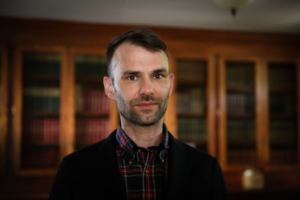
This fall, 11 new tenure-track faculty members joined Scripps College, including two at the W.M. Keck Science Department. As part of our ongoing series on faculty, the Scripps Office of Marketing and Communications recently sat down with Kevin Vennemann, assistant professor in the Department of German Studies. Vennemann received his BA and MA in literature and history from Free University of Berlin in 2006 and his PhD in German from New York University in 2015. His fields of interest include 19th-century comparative literature, theories of landscape, theories of fatigue and exhaustion, Holocaust studies, and art and architectural criticism. His most recent book, Sunset Boulevard: On Filming, Building, and Dying in Los Angeles (published in German in 2012), is an essayistic inquiry into the history of Hollywood cinema and the city of Los Angeles at the intersections of architecture, film, and race politics.
Scripps College: For your doctoral studies, you examined “fatigue” as an area of scholarship—you looked at the plight of 19th-century workers, exploring the philosophies of the Enlightenment era as they began to take effect. What discoveries regarding women’s choices from this period could you share with our students?
Kevin Vennemann: I discussed a few canonical 19th-century renderings of individual, cultural, and societal fatigue in art and literature, with a focus on Thomas Mann’s debut novel Buddenbrooks. Like so many other authors before him, Mann grapples with the seismic cultural and political shifts that unhinged most of the 19th century’s hitherto somewhat stable parameters. Two concurrent “discoveries,” two supposedly natural laws, had a specific impact on politics and culture post 1848: Karl Marx’s law of revolution, and the second law of thermodynamics, coined by physicists such as Hermann von Helmholtz, Kelvin, and others. Marx predicted the inexorable dialectic rise and subsequent victory of the working class over the bourgeoisie. The physicists, on the other hand, anticipated the equally inevitable decline and extinction of all civilization.
It was striking to me that, when I looked at the cultural repercussions of the 1848 revolutions, Marx’s law is frequently dismissed as a negligible threat, whereas the second law of thermodynamics is almost universally embraced as a quasi-poetics of the fatally fatigued second half of the century. I argue that this is one of the reasons why many examples of late 19th-century Western art and literature reflect on the newly tightened moral codes of the bourgeoisie. Hoping to diffuse the thermodynamic threat, these codes are supposed to force everyone, and specifically women, to perform their presumably innate social roles even more effectively than ever before. Nevertheless, the “immoral” woman is quickly stigmatized as the greatest internal threat to the dream of eternal human progress. “Immoral” here, of course, means “unmarried” or otherwise more empowered than women were supposed to be.
SC: In addition to German language classes, what other courses do you hope to develop given your current interests?
KV: I would be interested in developing classes on classical modernism, German and German-Jewish exile literature, Holocaust literature, post–WWII literature and pop culture, and anything that allows me to mix literature, theory, film, the visual arts, cinema, and architectural theory.
SC: What is your current research interest, and will your scholarship in this area provide insights or content for humanities lectures at Scripps?
KV: I just spent a year in Kyoto and Tokyo and immersed myself in everything Japanese—a field that was new to me, which is probably why the experience was all the more intense. I am now beginning to read and think and write a little more about the Western—specifically the German and American—colonial gaze on Japanese aesthetics since the mid-19th century. Specifically: How did the first modern Western travelers to Japan perceive—and appropriate—an architecture that would later become the blueprint for our own modern way to build? And what exactly is problematic about how those travelers talked at the time, and how the West still talks, about Japan? This project is so new, I am not entirely sure yet how to channel it into a syllabus. But it sure sounds like it could yield a great class.
SC: Do you have a random fact about yourself that is surprising, or that people don’t know about you, that you’d like to share with us?
KV: I beat box. Just for myself, not on a stage or anything. But I have been doing it for over 25 years. I think I am really good. Few people know. I can’t really do it when I’m asked to, but I sometimes will start beat boxing when I am absent minded, even in the presence of others. And I won’t notice until everybody else around has fallen silent and listens. My favorite beat to imitate is that of “Shook Ones Pt. II,” arguably the most famous track by legendary New York rappers Mobb Deep.

